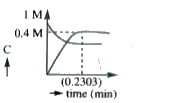
A→2B (1st order reaction) . If the rate constant is 9.7×10−x in min−1 then x=Solution in Telugu
The correct Answer is:1
(1−x) 2x
(1−0.2) 0.4
K=2.3030.2303×log(10.8)=10×log(108)=10×0.0970=0.970≅1=9.7×10−1
Topper's Solved these Questions
- BOOK - AAKASH SERIESCHAPTER - CHEMICAL KINETICSEXERCISE - PRACTICE SHEET-2 (SINGLE OR MORE THAN ONE OPTION QUESTIONS)16videos
CHEMICAL KINETICS
- BOOK - AAKASH SERIESCHAPTER - CHEMICAL KINETICSEXERCISE - PRACTICE SHEET-2 (LINKED COMPRHENSION TYPE QUESTIONS)6videos
CHEMICAL KINETICS
- BOOK - AAKASH SERIESCHAPTER - CHEMICAL KINETICSEXERCISE - PRACTICE SHEET-1 (MATCH THE FOLLOWING QUESTIONS)2videos
CHEMICAL KINETICS
- BOOK - AAKASH SERIESCHAPTER - CHEMICAL KINETCSEXERCISE - EXERCISE - 3.245videos
CHEMICAL KINETCS
- BOOK - AAKASH SERIESCHAPTER - CHEMICAL THERMODYNAMICSEXERCISE - Additional Practice Exercise54videos
CHEMICAL THERMODYNAMICS
Similar Questions
The rate constant (K) for the reactio. 2A+B→ Products was found to be
2.5×10−5litremol−1sec−1 after 15 sec, 2.60×10−5 litre mol−1sec−1 after 30 sec and 2.55×10−5 litre "mol"^(-1)"sec"^(-1) after 50 sec. The order of reaction is02:44View SolutionElemantary unimolecular reactions have first order rate laws, elementary bimolecular reactions have second order rate laws. A rate law is often derived from a proposed mechanism by imposing the state approximation or by assuming that there is a pre -equilibrium. A proposed mechanism must be consistent with the experiment rate law.
The decomposition of O3 obeys the mechanism give below
Step 1: O3⇔O2+(O) (both forward and backward reactions are fast)
Step 2: O3+(O)slow−−→O2+O2 (ignore) backward reaction), the rate of reaction is given byView SolutionMatch the following columns
 02:08View Solution
02:08View SolutionDiscuss on the kinetic spontaneity of a chemical reaction. Is a slow reaction spontaneous? Why?
08:47View SolutionWhich among the following is not an exact differential?
View SolutionThe rate constant of a first order reaction at 27∘Cis10−3min−1.The constant ( in min−1) at 17∘C for this reaction ?
02:49View SolutionThe rate constant of raction is 0.2 min−1. The order of the reaction is
02:49View SolutionThe rate constant of a reaction is 3xx10^(2)" min"^(-1) . What is the order of reaction ?
02:11View SolutionSelect the correct option for 1st order reaction 2A→product having rate constant of reaction 1.386×10−2min.
02:11View SolutionIn a first order reaction, the (a)/(a-x) was found to be 10 min. The rate constant is
02:37View SolutionThe time needed for the completion of 2/3 of a 1st order reaction, when rate constant is 4.771xx10^(-2)"min"^(-1) is
02:37View SolutionThe time needed for the completion of 2/3 of a 1st order reaction, when rate constant is 4.771×10−2min−1 is
02:17View SolutionWhat is the expression for rate constant for 1st order reaction ?
02:11View SolutionWhat is the expression for rate constant for 1st order reaction ?
01:58View SolutionThe rate constant of a reaction is 3xx10^2 min^-1 . What is the order of the reaction?
01:37View Solution

